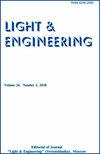Light Design: From Practice to Education
IF 0.3
4区 工程技术
Q4 ENGINEERING, ELECTRICAL & ELECTRONIC
引用次数: 0
Abstract
Nowadays, light design is not just a purely technical and functionally limited applied sphere but a sphere of active creative activity. Light engineering gradually moves rowards light design. This transformation has not just provided the latter with unlimited potential of design and art tools but has also provided it with a wide range of its capabilities, which makes it difficult for light design to self-identify to a certain extent. The processes provided light engineering with a variety of creative methods have dissolved the boundaries of the new profession still looking for self-identification. The contemporary trends in practical light design have allowed to identify the development direction more clearly, which allows us to enhance the education methodology. The conducted comparative analysis of the works by the leaders of international practice and professional education in the sphere of light design has identified a number of common trends, which allowed to set out the main methods of specialist training. A robust relationship between light design and theatre lighting and the use of the scenario-based principle of light modelling as well as the innovative experimental school laboratories equipped at the highest technical level and creative architectural and lighting design are becoming a most important component of future light designers training. The experience of training design is not only closely related to theory and methodology of technical aesthetic but also serves as a direct reflection of current design realia including artistic, media and information and engineering aspects.灯光设计:从实践到教育
如今,灯光设计已经不仅仅是一个单纯的技术和功能局限的应用领域,而是一个活跃的创造性活动领域。光工程逐渐向光设计发展。这种转变不仅为后者提供了无限的设计和艺术工具的潜力,而且为其提供了广泛的能力,这使得灯光设计在一定程度上难以自我认同。这些过程为光工程提供了各种创造性的方法,消解了新职业仍在寻找自我认同的界限。当代实用照明设计的趋势使我们能够更清晰地确定发展方向,从而使我们能够改进教育方法。国际实践和专业教育领域的领导者对灯光设计领域的作品进行了比较分析,确定了一些共同的趋势,从而可以制定专业培训的主要方法。灯光设计和剧院照明之间的牢固关系,使用基于场景的灯光建模原则,以及配备最高技术水平和创意建筑和灯光设计的创新实验学校实验室,正在成为未来灯光设计师培训的最重要组成部分。培训设计的经验不仅与技术美学的理论和方法论密切相关,而且直接反映了当前的设计现实,包括艺术、媒体和信息、工程等方面。
本文章由计算机程序翻译,如有差异,请以英文原文为准。
求助全文
约1分钟内获得全文
求助全文
来源期刊

Light & Engineering
ENGINEERING, ELECTRICAL & ELECTRONIC-OPTICS
CiteScore
1.00
自引率
50.00%
发文量
0
审稿时长
1 months
期刊介绍:
Our magazine
develops comprehensive communication within the lighting community, providing opportunities for discussion and free expression of opinions of specialists of different profiles;
contributes to the convergence of science and engineering practice, the search for opportunities for the application of research results in lighting and technological applications of light;
keeps the scientific community up to date with the latest advances in the theory of the light field, providing readers with operational professional information;
initiates international cooperation, promotes and distributes the results of Russian authors in the international professional community;
provides equal opportunities for authors from different regions of Russia and other countries.
The journal publishes articles in the following areas:
visual and non-visual effects of radiation on humans;
light field theory;
photometry and colorimetry;
sources of light;
ballasts;
light devices, their design and production technology;
lighting and irradiation installation;
light signaling;
methods of mathematical modeling of light devices and installations;
problems of energy saving in lighting, installation and operation of lighting installations;
modern production technologies of lighting products for lighting control systems;
innovative design solutions;
innovations in lighting and lighting design;
the study of the effect on plants and animals, problems of using light in medicine;
problems of disinfection of premises, water and smell elimination with the help of technology of UV radiation using;
problems of light in the ocean and space.
 求助内容:
求助内容: 应助结果提醒方式:
应助结果提醒方式:


